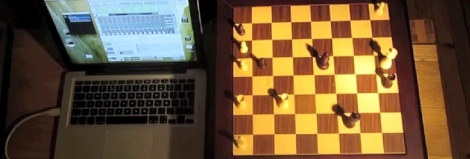[tinkartank] wrote in to tell us about the chess board step sequencer he built. It’s a great piece of work that combines the wonderful classical erudition a set of chess pieces confers with modern technological musical equipment such as a monome.
The build began by routing small holes underneath each square and fitting very small and fragile reed switches. Sixty four of these switches are wired into rows and columns then attached to the digital inputs of an Arduino Mega. To close these reed switches, magnets are implanted into the base of each chess piece so whenever a piece is on the board is moved a circuit closes.
On the control side of things, [tinkartank] built a very nice control panel to change the key being played*, the tempo, an ‘arpeggio dial,’ number of steps, and if there is a whole or half step in between notes. With this control panel, [tinkartank] can play just about any scale.
How does it sound? Well, the Arduino Mega outputs MIDI so realistically it can sound like anything imaginable. From the video demo (available after the break), we really like the interface and a reed switch array chess board is slowly climbing up our ‘to build’ list, if only for all the cool stuff you can do with one.
*Using H to denote the key of B is not uncommon in some parts of Europe. In this system, the key of Bb is notated as B and B is H.
















Nice!
If you hook this up with a game clock, every time you hit the clock it could play the “Song of the Board”. That way it isn’t just always going.
I love it!
“the Arduino Mega outputs MIDI so realistically it can sound like anything imaginable”…
*facepalm* From the top of the article: “The sequencer is connected to software synths on my Mac trough USB and a Processing patch to convert the serial data to internal midi.”
The Arduino isn’t even outputting MIDI at all, and even if it was, it wouldn’t matter how “realistically” it was doing so, as the synth is on the Mac, not the Arduino.
You are correct, sort of, the Auduino’s (and their clones)vary, some can output MIDI note messages over USB natively, others you can use a shield to convert to MIDI (over 5pin DIN MIDI cable)…
One can argue semantics over what the author meant by “the Arduino Mega outputs MIDI so realistically it can sound like anything imaginable”… Did th author think that the MIDI notes = Music? or was the author referring to the quality and range that the MCU can output?
The “Midi so realistically” is hack-a-days liitle blooper .. or joke ;-)
I claim in the very first sentence that I use software synths on a Mac to make the sound. However, the Midi-signals are real and are ready to be sent to a 5-pin DIN trough an optocoupler. I just need to adjust the baud rate. I was forced to use another baud rate because processing, which I use to convert the serial-port-midi to virtual-midi, only handles standard baud rates.
Later I have found out that there is already programs out there for doing this, which can obviously handle the real midi baud rate…
Quite amazing!